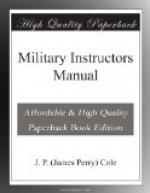Do not have any straggling, remember if a man falls out he must have a certificate signed by an officer stating the cause. Have one officer march in rear of the company. Be careful about the use of water. Have your men take a good drink early in the morning just after reveille, and on the march use their canteen sparingly. One canteen of water must last one man one day. Do not allow men to drink until after the second halt.
On reaching camp the kitchens are put up, latrines are dug, and tents are pitched. When everything has been tended to each man should give his feet a good salt water bath. Put them in the water and let them remain there for 2 minutes. Do not dry them by rubbing, but sponge them—this will harden the feet. This should be done for the first three days, after which it can be dispensed with. A change of socks daily should be made, take one pair of socks from the pack, and wash out the dirty pair.
Try to avoid night marching.
The leading company in each regiment regulates the rate of march.
“The marching efficiency of an organization is judged by the amount of straggling and elongation and the condition of the men at the end of the march.” (i.d.r., 632.)
Remember a sanitary squad should be detailed daily to police the immediate vicinity after each halt.
Field Work.
Field work will be classified under the following
heads: Orders,
Deployment, Fire, Attack, Defense, Leadership, Communications,
Night
Operations, Patrols, Advance Guards, Rear Guards,
Flank Guards, Camp,
March Outpost, and Outpost.
(a) AN ORDER is the will of the commander expressed
verbally or in
writing to his subordinates. It should be clear,
concise and to the
point. A field order should be given as follows:
1.
Information of the enemy and supporting troops.
2.
General plan of the commander.
3.
Dispositions of the troops.
4.
Instructions for the trains.
5.
Place where messages are to be sent.
(b) DO NOT DEPLOY too early. It is very fatiguing, and has a tendency to disorganize the skirmish line. The major designates the companies to be on the firing line, and those to remain in support. The distance between the firing line and support is from 50 to 500 yards. The support should be as close as possible under cover.
(c) FIRE DIRECTION is the function of the company commander. He gives each platoon its sector or objective, determines the range, target, indicates the class of fire, and the time to open fire. Fire control is given to platoon commanders. The platoon is the fire unit. “Fire control implies the ability to stop firing, change the sight setting and target, and resume a well directed fire. The best troops are those that submit longest to fire control.” Fire discipline is the function of the individual soldier. “It implies that in a firing line without leaders, each man retains his presence of mind and directs effective fire upon the target.”




